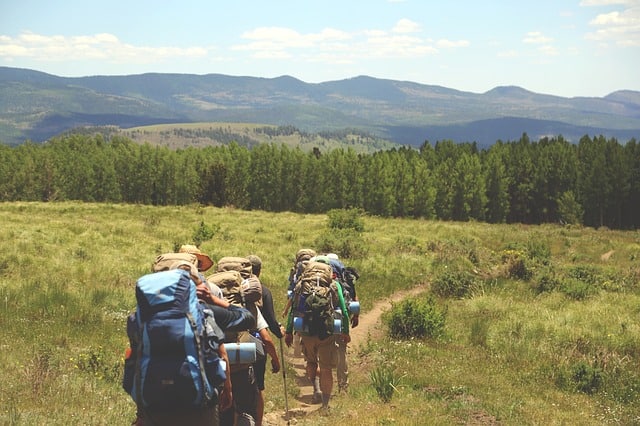Just because you love hiking and camping doesn’t mean you have to break the bank when buying gear. In fact, there are many great budget-friendly gear alternatives out there compared to more expensive high-end camping equipment. One great place to look for budget-friendly gear is in the backpacking pack category. Below we have compiled a list of some of the best budget backpacking pack options out there. We also cover how to choose the best backpacking pack for your needs and keys items to look for.
Best Budget Backpacking Pack Options
Teton Sports Explorer 4000 Internal Frame Backpack
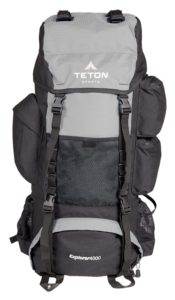 One of our favorite budget-friendly backpacking packs is the Teton Sports Explorer 4000 Internal Frame Backpack due to its larger size and versatility. The Teton Backpack has a 4000 cubic inch or (65L) capacity making it large enough to store all of your hiking and camping gear with ease. In fact, many reviewers have stated that there is so much room that they actually have extra space in the pack making it easier to get to needed items quickly. At 65L this is the largest backpack on this list allowing you store and hold enough food, water, and gear to hike or camp for a week or more at a time if you desire.
One of our favorite budget-friendly backpacking packs is the Teton Sports Explorer 4000 Internal Frame Backpack due to its larger size and versatility. The Teton Backpack has a 4000 cubic inch or (65L) capacity making it large enough to store all of your hiking and camping gear with ease. In fact, many reviewers have stated that there is so much room that they actually have extra space in the pack making it easier to get to needed items quickly. At 65L this is the largest backpack on this list allowing you store and hold enough food, water, and gear to hike or camp for a week or more at a time if you desire.
The Teton Backpacking pack also has many great features more commonly found on higher-end backpacks including an internal framework, adjustable padded shoulder pads and waist belt, integrated rain cover, and a separate sleeping bag compartment.
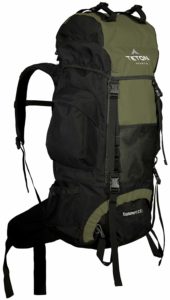 This backpack was made for long hikes and carrying large amounts of gear. Thanks to its internal framework and contoured design it provides just the right amount of comfort and support while on the trails saving your back, neck, and shoulders from unnecessary aches and pains.
This backpack was made for long hikes and carrying large amounts of gear. Thanks to its internal framework and contoured design it provides just the right amount of comfort and support while on the trails saving your back, neck, and shoulders from unnecessary aches and pains.
Another reason this budget backpacking pack is so popular is because of its quality construction and materials. This backpack uses 600D and ripstop material providing a rugged outer material that will stand up to years of outdoor use. In addition, the seams on this backpack are high quality and unlikely to tear or rip open.
ONEPACK 50L(45+5) Hiking Backpack
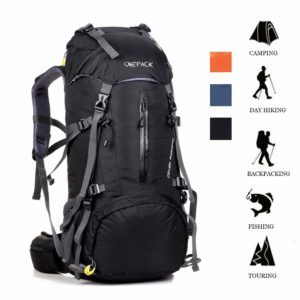 Another great economical backpacking pack option is Onepack 50L Hiking Backpack. While not as big as the Teton the ONEPACK at 50L still offers plenty of size and compartments to handle those longer hiking or camping trips. The bag features a large main compartment, two zippered front packs, a sleeping bag compartment, and mesh side pockets great for holding water bottles or miscellaneous items.
Another great economical backpacking pack option is Onepack 50L Hiking Backpack. While not as big as the Teton the ONEPACK at 50L still offers plenty of size and compartments to handle those longer hiking or camping trips. The bag features a large main compartment, two zippered front packs, a sleeping bag compartment, and mesh side pockets great for holding water bottles or miscellaneous items.
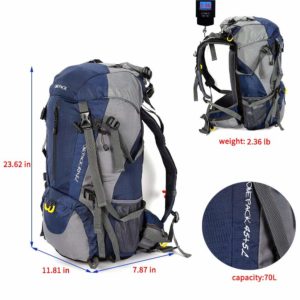 The ONEPACK offers plenty of comfort and adjustability to prevent soar and aching muscles while on the trail or at the campsite. Including padded adjustable shoulder straps, molded foam back panel, and a single aluminum contoured frame bar that provides rigidity and support to this best budget backpacking pack.
The ONEPACK offers plenty of comfort and adjustability to prevent soar and aching muscles while on the trail or at the campsite. Including padded adjustable shoulder straps, molded foam back panel, and a single aluminum contoured frame bar that provides rigidity and support to this best budget backpacking pack.
Sometimes with less expensive packs, you have to be concerned about the materials used and its build quality. However, with this best budget backpacking pack, there is no need to worry as it should allow for years of trouble-free use, thanks in large part to its Polyester+ nylon fabric that helps prevent tears or rips as well as its quality build and heavy duty stitching.
G4Free Large 40L Lightweight Water Resistant Travel Backpack
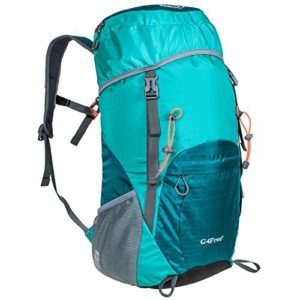 The smallest budget backpacking pack on the list is the G4Free Large 40L Lightweight Water Resistant Travel Backpack. While this bag is not big enough for week-long hiking and or camping excursions it makes a great option for quick one or two-day trips when you don’t need to carry and store a lot of extra gear. The 40L size still provides plenty of room to store a small sleeping bag, tent, and an assortment of other items especially if you use the external loops and mesh pockets.
The smallest budget backpacking pack on the list is the G4Free Large 40L Lightweight Water Resistant Travel Backpack. While this bag is not big enough for week-long hiking and or camping excursions it makes a great option for quick one or two-day trips when you don’t need to carry and store a lot of extra gear. The 40L size still provides plenty of room to store a small sleeping bag, tent, and an assortment of other items especially if you use the external loops and mesh pockets. 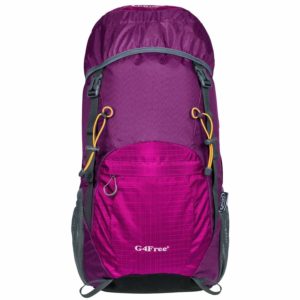
While there is no internal framework on this best budget backpacking pack it still provides plenty of comforts while on the trails. The G4Free pack features adjustable padded shoulder straps as well as a built-in chest strap to help disperse the load more evenly and keep the pack stable while hiking and moving.
One great option for this backpack is to use it as a lightweight daypack that can easily be stored inside a larger backpacking pack. The G4Free is not only lightweight but also has the unique feature of being able to fold down into a handy carrying case allowing you to be ready for those quick day trips in a moments notice without having to take a large bulky pack.
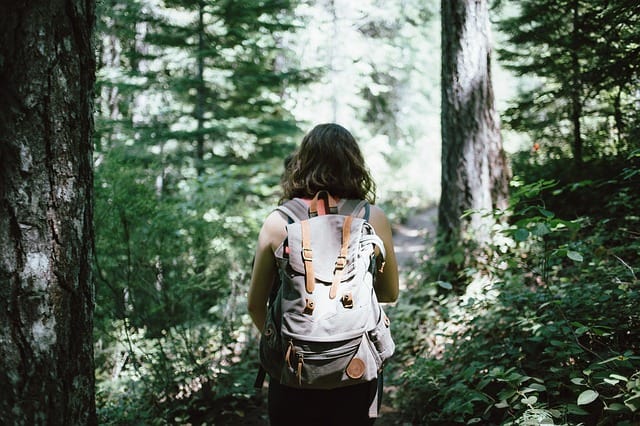
How to Choose the Best Budget Backpacking Pack
There are several key points to keep in mind when choosing the best budget backpacking pack for your needs including pack size, pack fit and adjustability, frame or no frame, and storage compartments and options.
Backpack Size
Backpacking packs come in varying sizes in order to fit a variety of needs and gear situations. For example, someone doing a short day hike will need considerably less gear than someone hiking and camping for an entire week.
Backpack sizes can be broken down into three main categories.
- Overnight Packs: Usually Less than 35 Liters in Size
- Weekend Packs: Between 35 and 50 Liters in Size
- Multiday Packs: Between 50 and 75 Liters in Size
It’s important to pick the appropriate size pack for your hiking and camping needs to ensure that you have enough room for your camping gear but not more room than you need to help keep weight down.
Backpack Fit
After backpack size, the next most important item to consider is the fit of the backpacking pack. Because we are not all the same size we all have slightly different needs when it comes to the fit and dimensions of the backpack. Because of this, it’s important to choose a backpack that can be fully customizable to your body type and size.
When choosing a backpacking pack look for things such as adjustable shoulder straps, adjustable hip belt, and adjustable sternum or chest straps. These adjustments will allow you to fully customize the hiking backpack to your specific size and needs.
If you still have questions about backpack fit check out this helpful video that discusses proper size and adjustments for backpacks.
Frame or No Frame
Often times beginners have questions on whether to go with a pack with or without a frame. The answer to this question really depends on your needs and hiking duration.
The longer and more rugged your hiking will be the more you need to have an external or internal frame to your backpack. Backpack frames help to stabilize and support the weight of your pack while you are on the trail.
If however, you are planning an afternoon hike or short day hike external or internal frames are less important. While you can still use a backpack with a frame on short hikes it is usually unnecessary and the benefits of a backpack frame are outweighed by the negatives on short hiking trips. As short hikes don’t usually need the extra support of a frame but add additional weight to the pack and make the pack harder to maneuver in tight spaces while day hiking.
Storage and Compartments
Lastly when choosing a backpacking pack its important to keep in mind how you will be using the pack and what you need to store inside or on the backpack. Backpacks can have all different kinds of compartments, straps, and storage pockets allowing you to store a variety of items both big and small.
So when choosing a pack make sure to take into consideration the items you want to bring along while hiking or camping and look for a backpack that will do the best job in carrying those items.
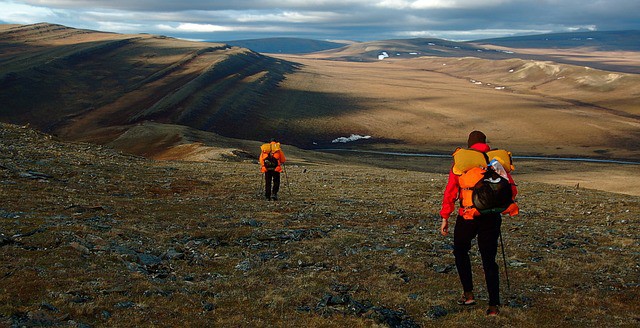
Key Items to Look for with Budget Backpacking Packs
- Look for quality materials and construction.
- Look for versatility and storage options.
- Make sure to choose the appropriate size for your needs.
- Keep in mind usability and make sure the pack offers the features and or accessories you need.

